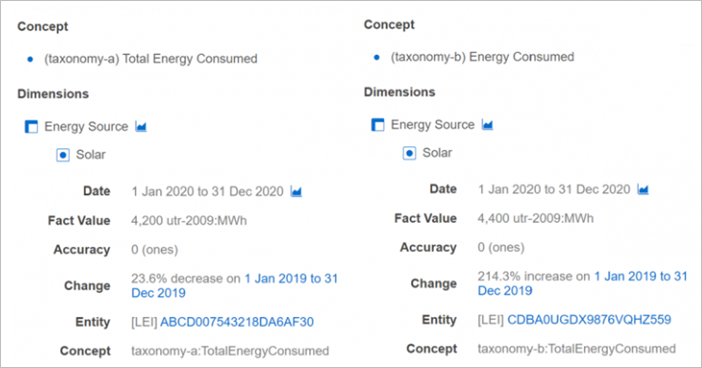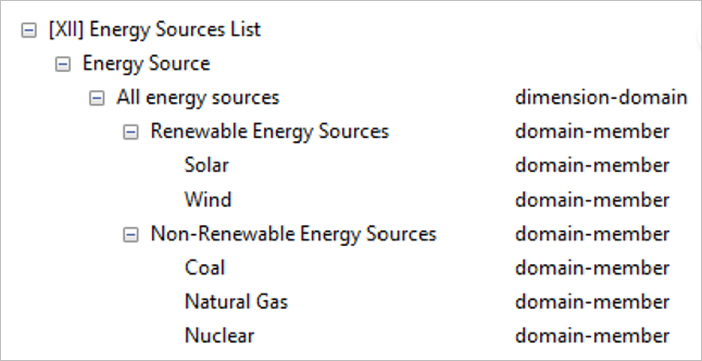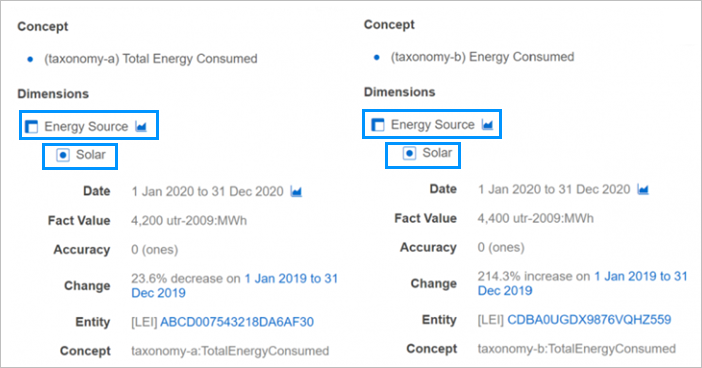Share lists between taxonomies
In XBRL, users can share lists of commonly used values and notations between taxonomies.
There are many sustainability standards and in each standard, there are sections that take the form of lists. These lists often present similar common information across different standards.
Examples of lists common in sustainability reports:
- Greenhouse gases
- Sources of energy
- Country codes
Standard setters can collaborate on certain areas of their standards, define common lists, and share those lists so they can be reused between taxonomies. This collaboration reduces the risk of duplicating the effort of creating the lists separately for each taxonomy. Additionally, sharing lists ensures the lists are compatible across different standards.
XBRL standard and sharing lists
Shared lists can be used to define various elements in an XBRL taxonomy, for example, dimension values. Shared lists allow standard setters to group, filter and link information.
Advantages of sharing lists:
- A shared list that is used by several taxonomies is shared from one location.
When a shared list is updated, all taxonomies that use that shared list are updated automatically. There is no need to manually update the list in each taxonomy. - Sharing lists ensures consistent tag naming across all reports using the same shared list.
If taxonomies don’t share their lists, a list of similar information may use different naming. Thanks to shared lists, data preparers don’t need to search for different tag names that define the same information. - Using shared lists speeds up the reporting process.
Because there are fewer shared lists in comparison to having similar lists in each sustainability standard, data preparers can use the same lists multiple times. They become familiar with the lists and with the information they contain. - It is easier to analyse data with shared lists.
Data consumers only need to understand one set of information, instead of multiple lists, in multiple sustainability standards. For example, data consumers need to understand only one set of energy sources, used consistently across multiple reports.
Example
Two companies, CarMaker and VanBuild, report their annual sustainability report. Each uses its own, independent taxonomy to prepare their reports in the XBRL standard.
Here are both of their reports:
CarMaker Sustainability Disclosure
VanBuild Sustainability Disclosure
They report their total energy consumed against different concepts, specific to the taxonomies provided to them by their standard setters. CarMaker reports against Total Energy Consumed, and VanBuild reports against Energy Consumed.

However, standard setters of both taxonomies apply a shared dimension, Energy Source, to both of those taxonomy concepts.

Thanks to that, despite using different taxonomies and taxonomy-specific concepts, both companies use the same Dimension, Energy source, and Dimension value, Solar. Data preparers set applicable dimension values to provide more details on their energy consumed.

More detail
Creating and managing shared lists
Standard setters need to identify which of their lists are worth sharing and share them with other standard setters. They should also use lists that were shared by other standard setters.
There are many approaches that we can take to create and manage shared lists:
- A standard setter that owns a particular standard publishes a small taxonomy with only the list they want to share.
Other standard setters implement that small taxonomy to describe that particular topic.
For example, an organisation that manages and defines the standard for country codes, publishes a small taxonomy with a list of countries and their country codes. Other standard setters use that list, published as a taxonomy, whenever they need to define a country using a country code. - A standard setter publishes a list that is already machine-readable, and XBRL International converts the list into an XBRL list.
The XBRL list is managed by the entity that published the list but cooperates with XBRL International to make it available for other XBRL users. - Two or more standard setters agree to use the same list between their standards and ask XBRL International to prepare a list.
The standard setters then manage, update, and use that shared list.
It is important that standard setters cooperate with other standard setters in creating and sharing lists to minimise the risk of incompatible standards.
Technical implementers should remember to put their own references on the shared lists they use in their taxonomies. While preparing the taxonomy, standard setters need to define that the taxonomy should include that reference to a shared list.
Taxonomies change annually. Standard setters should use this opportunity to improve their taxonomies by introducing more shared lists.
Consuming shared lists
Taxonomies have a standard built-in mechanism to specify all the files that make up that taxonomy. The taxonomy directly references shared lists. Data consumers and data preparers do not need to do anything to use and consume shared lists. When the shared list is included in the taxonomy, the consuming software sees the shared list automatically.